|
|
|
Sort Order |
|
|
|
Items / Page
|
|
|
|
|
|
|
| Srl | Item |
| 1 |
ID:
093469
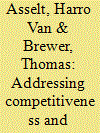

|
|
|
|
|
| Publication |
2010.
|
| Summary/Abstract |
The implementation of climate policies in the US and EU in light of uncertainties about future international climate policy has shifted attention to two interrelated concerns, namely competitiveness and carbon leakage. Although various policy measures are available to address these concerns, there has been much discussion about one such measure in particular: the use of offsetting measures at the border. This article compares policy discussions in the US and the EU on how to address competitiveness and carbon leakage concerns, with a focus on the role of import-related border adjustment measures. It analyses the kinds of measures that so far have been put forward with a view to addressing competitiveness and carbon leakage; compares the approaches to the problems in the US and the EU; and provides a preliminary discussion of international cooperation on border adjustment measures. It concludes that two kinds of cooperation are needed between the EU and the US - not only cooperation through formal international negotiations, but also cooperation through international learning processes, in which the EU and the US learn from each other about design and implementation issues as they develop their respective cap-and-trade systems.
|
|
|
|
|
|
|
|
|
|
|
|
|
|
|
|
| 2 |
ID:
191244


|
|
|
|
|
| Summary/Abstract |
The European Union (EU) recently declared its intention to implement a carbon border adjustment mechanism (CBAM) to address carbon leakage and competitiveness concerns associated with elevated climate ambitions in its Green Deal. Current literature points to uncertainties regarding the CBAM’s effectiveness and compatibility with international trade rules. This study numerically evaluates how alternative EU CBAM designs under various international reactions affect global and regional GHG emissions, outputs and trade flows.
|
|
|
|
|
|
|
|
|
|
|
|
|
|
|
|
| 3 |
ID:
183565
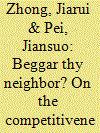

|
|
|
|
|
| Summary/Abstract |
Curbing climate change is gaining increasing consensus globally. While many countries seek to set carbon prices, significant price dispersion and policy stringency continue to raise concerns about competitiveness. To address this issue, the EU has proposed a carbon border adjustment mechanism (CBAM), which aims to level the playing field by levying a carbon price on EU imports. In this paper, we estimate the competitiveness and welfare impacts of the EU CBAM, based on a refined multi-regional IO approach. We quantify changes in the value of exports to the EU market upon CBAM implementation for both EU members and non-EU economies. It is found that the EU CBAM will lead to a redistribution of competitiveness among countries and regions. Specifically, it is estimated that EU output would increase by 0.38 per cent while output in rest of the world decreases by 0.1 per cent in the short run, when CBAM is set at $US100/tCO2e. The burden is unevenly distributed among regions, with China, Russia and India bearing the most. Moreover, a deeper sub-national-level analysis on China shows that, given its pervasive domestic production network, income losses in landlocked provinces exceed their export losses, contrasting with the pattern for trade-exposed provinces.
|
|
|
|
|
|
|
|
|
|
|
|
|
|
|
|
| 4 |
ID:
150467


|
|
|
|
|
| Summary/Abstract |
This paper quantifies the CO2 emissions embodied in bi-lateral trade between Australia and China using a sectoral input–output model. The results revealed: (1) that China performs lower than Australia in clean technology in the primary, manufacturing, energy sectors due to their overuse of coal and inefficient sectoral production processes, and (2) that China had a 30.94 Mt surplus of bi-lateral CO2 emissions in 2010–2011 and (3) overall global emissions were reduced by 20.19 Mt through Australia–China trade in 2010–2011. The result indicates that the greater the energy efficient a country among the trading partners the lower will be the overall global CO2 emissions. Global emissions decreased mainly because China consumed Australian primary products rather than producing them. Australia is an energy efficient producer of primary products relative to China. The bilateral trade compositions and trade volume played an important role in lowering global emissions and therefore one can view proposed China Australia Free trade Agreement positively in reducing global emissions. However, for the sustainable development, China should strengthen clean energy use and both countries should adopt measures to create an emission trading scheme in order to avoid protectionism in the form of future border price adjustments.
|
|
|
|
|
|
|
|
|
|
|
|
|
|
|
|
| 5 |
ID:
094845


|
|
|
|
|
| Publication |
2010.
|
| Summary/Abstract |
Unilateral or sub-global policies to combat climate change are potentially sensitive to free-riding and carbon leakage. One way of dealing with carbon leakage and competitiveness is the imposition of border adjustment measures for competing imports, for example in the form of the obligation to importers of goods to purchase and surrender emissions allowances to the authorities when importing. In this paper, we explore some implications of border adjustment measures in the EU ETS, for sectors that might be subject to carbon leakage. We examine the implications of two variants of these measures on the competitiveness of these sectors and on the global environment with the help of a multi-sector, multi-region computable general equilibrium (CGE) model of the global economy. Our calculations suggest that border adjustment might reduce the sectoral rate of leakage of the iron and steel industry rather forcefully, but that the reduction would be less for the mineral products sector, including cement. The reduction of the overall or macro rate of leakage would be modest. So, from an environmental point of view border tax adjustments would not be a very effective policy measure, but might mainly be justified by considerations of sectoral competitiveness.
|
|
|
|
|
|
|
|
|
|
|
|
|
|
|
|
| 6 |
ID:
150462
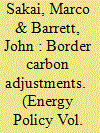

|
|
|
|
|
| Summary/Abstract |
Approximately one fourth of global emissions are embodied in international trade and a significant portion flows from non-carbon-priced to carbon-priced economies. Border carbon adjustments (BCAs) figure prominently as instruments to address concerns arising from unilateral climate policy. Estimating the volume of emissions that could be potentially taxed under a BCA scheme has received little attention until now. This paper examines how a number of issues involved in the implementation of BCAs can affect their ability to cover emissions embodied in trade and thus address carbon leakage. These issues range from ensuring compliance with trade provisions and assumptions on the carbon intensity of imports, to determining which countries are included and whether intermediate and final demand are considered. Here we show that the volume of CO2 captured by a scheme that involved all Annex B countries could be significantly reduced due to these issues, particularly by trade provisions, such as the principle of ‘best available technology’ (BAT). As a consequence, the tariff burdens faced by non-Annex B parties could dwindle considerably. These findings have important policy implications, as they question the effectiveness and practicalities of BCAs to reduce carbon leakage and alleviate competitiveness concerns, adding further arguments against their
|
|
|
|
|
|
|
|
|
|
|
|
|
|
|
|
| 7 |
ID:
166307
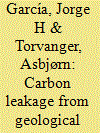

|
|
|
|
|
| Summary/Abstract |
A number of studies show that large-scale deployment of Carbon Capture and Storage (CCS) is necessary to limit the increase in global average temperature to less than 2 °C by 2100. However, some experts and citizens worry about the integrity of carbon dioxide storage sites due to the possibility of future leakage. We introduce a two-period model where two emission mitigation technologies are available to society in the first period: CCS, with a risk of carbon dioxide leakage in the second period, and a riskless mitigation alternative, such as renewable energy. We first solve the model assuming that society does not know what the future rate of leakage will be. We then solve the model assuming that society will eventually learn the actual leakage rate. We find that, in a trading market in period one, reductions of CO2 emissions through CCS should generate a less than proportional amount of CO2 allowances. Estimates from simulations, using a coarse range of parameters, indicate that the discount factor of CCS allowances lies in the range (0.72, 1). Site-specific data is required to determine site-specific risks of leakage and discount factors.
|
|
|
|
|
|
|
|
|
|
|
|
|
|
|
|
| 8 |
ID:
176695


|
|
|
|
|
| Summary/Abstract |
There are overwhelming proofs that world-wide carbon emission profiles have been substantially shaped by carbon leakage through international trade. However, it has been unclear how structure and functions of the global carbon transfers evolve in terms of a complex network. Therefore, this study applies a series of network tools to depict the evolution features of the global carbon flow network from 1995 to 2011 as supported by a systems multi-regional input-output analysis. At global level, the network density increases essentially, indicating the widely expanding carbon leakages among economies. The increasingly distinct scale-free distribution for cumulative degree/weighted degree implies the network's intensified heterogeneity structure. At regional level, a new tripartite cluster structure has been identified by the three gradually stabilized communities centered on USA, China and Europe. At national level, the evolution for all economies' roles, especially two prominent groups (i.e. G8 and BRICS), is enunciated by coreness in context of the core-periphery structure, highlighting the significance of monitoring core economies' carbon emission flows. The results urge the need to shift from local carbon mitigation in silos to global collective and inclusive governance. Regional cluster structure's identification highlights the urgency for multinational cooperation on emission mitigation within the three newly formulated communities.
|
|
|
|
|
|
|
|
|
|
|
|
|
|
|
|
| 9 |
ID:
127302
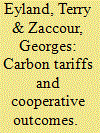

|
|
|
|
|
| Publication |
2014.
|
| Summary/Abstract |
In the absence of an international environmental agreement (IEA) on climate change, a country may be reluctant to unilaterally implement environmental actions, as this may lead to the relocation of firms to other, lax-on-pollution countries. To avoid this problem, while still taking care of the environment, a country may impose a carbon tariff that adjusts for the differences between its own carbon tax and the other country's tax. We consider two countries with a representative firm in each one, and characterize and contrast the equilibrium strategies and outcomes in three scenarios. In the first (benchmark) scenario, in a first stage the regulators in the two countries determine the carbon taxes noncooperatively, and in a second stage, the firms compete à la Cournot. In the second scenario, the regulators cooperate in determining the carbon taxes, while the firms still play a noncooperative Cournot game. In the third scenario, we add another player, e.g., the World Trade Organization, which announced a border tax in a prior stage; the game is then played as in the first scenario. Our two major results are (i) a border-tax adjustment (BTA) mimics quite well the cooperative solution in setting the carbon taxes as in scenario two. This means that a BTA may be a way around the lack of enthusiasm for an IEA. (ii) All of our simulations show that a partial correction of the difference in taxes is sufficient to maximize total welfare. In short, the conclusion is that a BTA may be used as a credible threat to achieve an outcome that is very close to the cooperative outcome.
|
|
|
|
|
|
|
|
|
|
|
|
|
|
|
|
| 10 |
ID:
179723


|
|
|
|
|
| Summary/Abstract |
This paper provides a review of the recent academic literature on how individual countries or regions can successfully implement unilateral climate policies in an increasingly integrated world economy. It first reviews the theory, empirics and future projections of ‘carbon leakage’, i.e. the notion that more ambitious climate policies will pose an incentive for energy-intensive industries to relocate and thus undo at least some of the achieved emission reductions. It then discusses measures to reduce carbon leakage. These include free allocation of emission permits to firms deemed at risk of carbon leakage, targeted trade policies as well as international cooperation to promote climate policies in third countries. Finally, it provides an overview of the debate on responsibility for trade-related emissions, including production- and consumption-based emission accounting as well as some more recent approaches.
|
|
|
|
|
|
|
|
|
|
|
|
|
|
|
|
| 11 |
ID:
126075
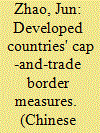

|
|
|
|
|
| Publication |
2013.
|
| Summary/Abstract |
Certain developed countries are exploring the possibility of imposing border measures to address the issues of "competitive disadvantage" and "carbon leakage" caused by asymmetric climate change policies in different countries. This article examines whether these border measures can satisfy the chapeau requirement1 under Article XX of GATT, which is probably the most significant procedural hurdle under the WTO framework. Furthermore, this article takes stock of China's domestic actions to combat climate change as well as their potential effectiveness, and then analyses the motivations behind those actions.2 After that, this article probes into China's potential advisable reactions towards these possible border measures, including China's domestic institutional building.
|
|
|
|
|
|
|
|
|
|
|
|
|
|
|
|
| 12 |
ID:
171425
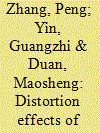

|
|
|
|
|
| Summary/Abstract |
Emissions Trading System (ETS) only regulates above-threshold emission sources in the covered sectors due of administrative costs consideration. Due to differentiated cost burdens on regulated- and unregulated-emission sources, ETS may give rise to intra-sector competition distortion and carbon leakage within a regulated sector. For developing countries where the industrial concentration is relatively low, such defects are more significant since unregulated emission sources as a whole accounts for an unneglectable portion of the regulated emission sectors' total production capacity and emissions. By applying a theoretical model, we conclude that unintended transfer payment from regulated emission sources' capital factor to unregulated emission sources’ labor factor causes intra-sector competition distortion. We find that the labor factor cost within a regulated sector remains homogeneous, while the homogeneity of capital factor cost is broken by ETS, causing unintended transfer payment. We have developed the I-SEE (Intra-Sector Equilibrium Evaluation) model to quantitatively assess the intra-sector effect caused by ETS. We suggest that sufficient attention should be paid to balancing the environmental costs borne by regulated and unregulated emission sources in ETS design to avoid unintended transfer payment. A properly designed carbon tax can help correct the intra-sector distortion caused by ETS.
|
|
|
|
|
|
|
|
|
|
|
|
|
|
|
|
| 13 |
ID:
112932
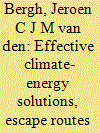

|
|
|
|
|
| Publication |
2012.
|
| Summary/Abstract |
Many well-intended climate-energy strategies are ineffective in the absence of serious environmental regulation. This holds, among others, for direct support of clean energy, voluntary energy conservation, technical standards on a limited set of products, unilateral stringent carbon pricing, and awaiting peak oil as a climate strategy. All of these suffer from "escape routes" that indirectly increase CO2 emissions and thus make the original strategy ineffective. On the other hand, environmental regulation alone may lead to a myopia-bias, stimulating early dominance of cost-effective technologies and a focus on incremental innovations associated with such technologies rather than on radical innovations. Although adopting a partial viewpoint keeps the analysis simple, we urgently need a more inclusive systems perspective on climate solutions. This will allow the formulation of an effective climate policy package that addresses the various escape routes.
|
|
|
|
|
|
|
|
|
|
|
|
|
|
|
|
| 14 |
ID:
125838


|
|
|
|
|
| Publication |
2013.
|
| Summary/Abstract |
To address the climate change issue, developed nations have considered introducing carbon pricing mechanisms in the form of a carbon tax or an emissions trading scheme (ETS). Despite the small number of programmes actually in operation, these mechanisms remain under active discussion in a number of countries, including Japan. Using an input-output model of the Japanese economy, this article analyses the effects of carbon pricing on Japan's industrial sector. We also examine the impact of a rebate programme of the type proposed for energy-intensive trade-exposed (EITE) industries in U.S. legislation, the Waxman-Markey Bill (H.R. 2454), and in the European Union's ETS. We find that a carbon pricing scheme would impose a disproportionate burden on a limited number of sectors - namely, pig iron, crude steel (converters), cement and other EITE industries. Out of 401 industries, 23 would be eligible for rebates according to the Waxman-Markey-type programme, whereas 122 industries would be eligible for rebates according to the E.U.-type programme, if adopted in Japan. Overall, despite the differences in coverage, we find that the Waxman-Markey and E.U. rebate programmes have roughly similar impacts in reducing the average burden on EITE industries.
|
|
|
|
|
|
|
|
|
|
|
|
|
|
|
|
| 15 |
ID:
094937


|
|
|
|
|
| Publication |
2010.
|
| Summary/Abstract |
The new ETS Directive defines three different allocation rules, granting exemption from auctioning to those sectors exposed to the risk of Carbon Leakage. This article analyses the inconsistencies that characterize this new allocation rule and it concludes that the methodology designed to assess the risk of Carbon Leakage is more politically driven than economically grounded. The results of the Carbon Leakage risk assessment reveal that grandfathering is going to be the dominant allocation rule during the third phase also. However, not only the exemption from auctioning is unlikely to mitigate Carbon Leakage, instead of improving the allocation transparency and granting harmonization of higher rules but also the new ETS allocation rule is likely to increase the distortions of competition, worsening rather than improving the harmonization within the ETS.
|
|
|
|
|
|
|
|
|
|
|
|
|
|
|
|
| 16 |
ID:
126590
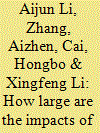

|
|
|
|
|
| Publication |
2013.
|
| Summary/Abstract |
There have been growing clamours for carbon-motivated border tax adjustments (CBTAs) targeted at countries that do not accept the carbon emission reduction targets. Currently, China is the largest carbon emitter with large annual incremental carbon emissions and might have to face the challenge of CBTA. Therefore, it is a pressing policy challenge for the government to get prepared for mitigating the negative impacts of CBTAs on China. In this article, we compare the impacts of CBTAs across large developing economies and compare the performances of different policy options to mitigate the negative impacts. The main findings are as follows. First, CBTA would affect different economies and different sectors differently. CBTA would result in a shift of production across sectors and relocation of output from the target countries to CBTA users. Second, CBTA would contribute to world's emissions reduction, but less than expected due to carbon leakage. Finally, policy options, which could reduce the present distorting effects, would be preferred to other policy options that would add additional distorting effects to the economy. Looking ahead, the Chinese government should get prepared for mitigating the negative impacts of CBTAs because its economy could be adversely affected.
|
|
|
|
|
|
|
|
|
|
|
|
|
|
|
|
| 17 |
ID:
098607


|
|
|
|
|
| Publication |
2010.
|
| Summary/Abstract |
Border adjustments are currently discussed to limit the possible adverse impact of climate policies on competitiveness and carbon leakage. We discuss the main choices that will have to be made if the European Union implements such a system alongside the EU ETS. Although more analysis is required on some issues, on others some design options seem clearly preferable to others. First, the import adjustment should be a requirement to surrender allowances rather than a tax. Second, the general rule to determine the amount of allowances per ton imported should be the product-specific benchmarks that the European Commission is currently elaborating for a different purpose (i.e. to determine the amount of free allowances). Third, this obligation should apply when the imported product is registered at the EU border, and not after the end of the year as is the case for domestic emitters. Fourth, the export adjustment should take the form of a rebate on the amount of allowances a domestic emitter has to surrender. Five, this rebate should equal the above-mentioned product-specific benchmarks, not the emissions of the particular exporting plant or firm. Finally, the adjustment does not have to apply to consumer products but mostly to basic products.
|
|
|
|
|
|
|
|
|
|
|
|
|
|
|
|
| 18 |
ID:
116923
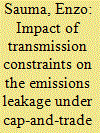

|
|
|
|
|
| Publication |
2012.
|
| Summary/Abstract |
Several regional cap-and-trade (C&T) programs are considered or implemented in the United States to control greenhouse gas emissions from the power sector. One concern is the possibility of emissions leakage due to a lack of coherence in the geographic scope of the regional electricity market and the C&T program. Leakage in the context of regulating CO2 emissions is defined as the short-run displacement of CO2 emissions from the capped region to other uncapped regions due to the imposition of a regional C&T scheme. However, the presence of transmission congestion could interact with regulations in an unanticipated way to determining whether leakage would occur and its magnitude if happens. In this paper, we use a two-node network to study the conditions under which the CO2 leakage would happen in a radial network under a C&T program. These conditions are related to transmission capacity, merit order change, and relative production cost between capped and uncapped regions. Since CO2 leakage would likely occur in a radial network during the time when there is surplus transmission capacity, if regional CO2 policies could influence power grid management and operations decisions, then there might be space for a better multi-objective coordination.
|
|
|
|
|
|
|
|
|
|
|
|
|
|
|
|
| 19 |
ID:
185702


|
|
|
|
|
| Summary/Abstract |
Decarbonisation implies conversion to electrification with a subsequent increase in electricity consumption. The EU Emission Trading System (EU ETS) compensates firms for the higher electricity costs. We exploit sectoral and country differences in regulation and a unique dataset on beneficiaries to evaluate the impact of EU ETS indirect cost compensation on the performance of aided firms. Receiving compensation for indirect costs does not have a statistically significant impact on labour productivity. Conversely, there is evidence of a negative performance in terms of turnover, value of total assets and employment of beneficiaries. Results suggest that the amounts transferred to firms might not fully compensate for the higher cost of energy in aided countries. However, the negative effects fade in sectors more exposed to carbon leakage risk. As far as aid intensity is concerned, estimates imply that higher compensation amounts improve performance.
|
|
|
|
|
|
|
|
|
|
|
|
|
|
|
|
| 20 |
ID:
169740


|
|
|
|
|
| Summary/Abstract |
Interconnected regional electricity markets are often subject to asymmetric carbon policies with partial coverage for CO2 emissions. While the resulting problem of carbon leakage has been well studied, its mitigation has received relatively less attention. We devise a proactive carbon policy via a bi-level modelling approach by considering the impact of an emission cap that limits the cost of damage from a regional power market. In particular, a welfare-maximising policymaker sets the cap when facing profit-maximising producers and the damage costs from their emissions at two nodes. A partial-coverage policy could degrade maximised social welfare and increase total regional CO2 emissions with potential for carbon leakage due to a higher nodal price difference. A modified carbon policy that considers CO2 emissions from both nodes tightens the cap, which increases maximised social welfare and decreases total CO2 emissions vis-à-vis the partial-coverage policy, albeit at the cost of greater scope for carbon leakage as it causes nodal prices to diverge. As a compromise, an import-coverage policy, implemented by California, that counts only domestic and imported CO2 emissions could alleviate carbon leakage at the cost of lower maximised social welfare with higher total emissions vis-à-vis the modified-coverage policy.
|
|
|
|
|
|
|
|
|
|
|
|
|
|
|
|
|
|
|
|
|